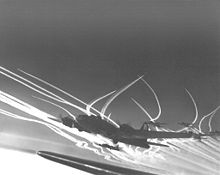| 571st Strategic Missile Squadron | |
|---|---|
 LGM-25C Titan II Test Launch at Vandenberg AFB, California | |
| Active | 1942–1945; 1962–1983 |
| Country | |
| Branch | |
| Type | Squadron |
| Role | Intercontinental ballistic missile |
| Engagements | European Theater of Operations |
| Decorations | Distinguished Unit Citation Air Force Outstanding Unit Award |
| Insignia | |
| 571st Strategic Missile Squadron emblem [a] |  |
| 571st Bombardment Squadron emblem [1] |  |
| World War II fuselage identification code [1] | FC |
The 571st Strategic Missile Squadron is an inactive United States Air Force unit. It was last assigned to the 390th Strategic Missile Wing at Davis-Monthan Air Force Base, Arizona. It was equipped with the LGM-25C Titan II intercontinental ballistic missile, with a mission of nuclear deterrence. The squadron was inactivated as part of the phaseout of the Titan II on 3 December 1983.
Contents
- History
- World War II
- Intercontinental ballistic missiles
- Lineage
- Assignments
- Stations
- Aircraft and missiles
- Awards and campaigns
- See also
- References
- Notes
- Bibliography
The squadron was first activated during World War II as the 571st Bombardment Squadron. After training in the United States, it deployed to the European Theater of Operations, where it participated in the strategic bombing campaign against Germany. It was twice awarded the Distinguished Unit Citation for its actions in combat. After V-E Day, the squadron returned to the United States, where it was inactivated in August 1945.




